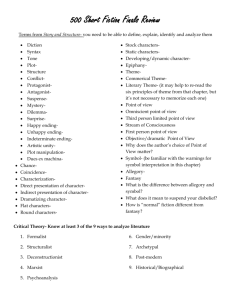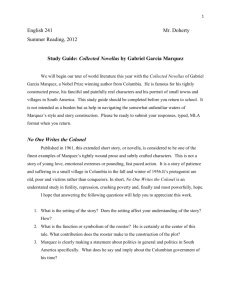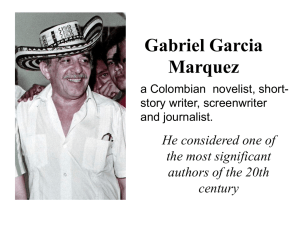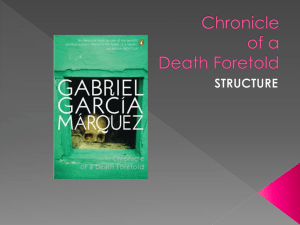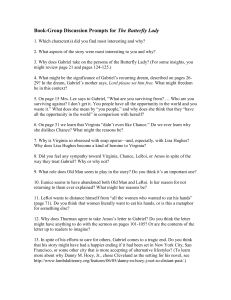Chronicle of a Death Foretold
advertisement
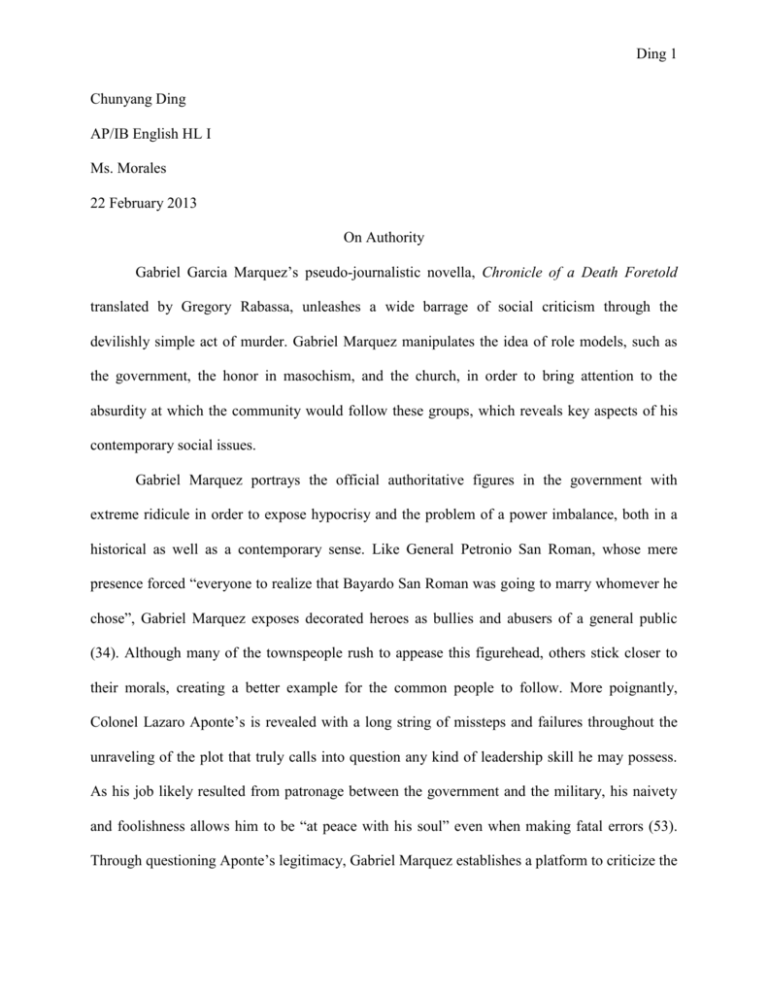
Ding 1 Chunyang Ding AP/IB English HL I Ms. Morales 22 February 2013 On Authority Gabriel Garcia Marquez’s pseudo-journalistic novella, Chronicle of a Death Foretold translated by Gregory Rabassa, unleashes a wide barrage of social criticism through the devilishly simple act of murder. Gabriel Marquez manipulates the idea of role models, such as the government, the honor in masochism, and the church, in order to bring attention to the absurdity at which the community would follow these groups, which reveals key aspects of his contemporary social issues. Gabriel Marquez portrays the official authoritative figures in the government with extreme ridicule in order to expose hypocrisy and the problem of a power imbalance, both in a historical as well as a contemporary sense. Like General Petronio San Roman, whose mere presence forced “everyone to realize that Bayardo San Roman was going to marry whomever he chose”, Gabriel Marquez exposes decorated heroes as bullies and abusers of a general public (34). Although many of the townspeople rush to appease this figurehead, others stick closer to their morals, creating a better example for the common people to follow. More poignantly, Colonel Lazaro Aponte’s is revealed with a long string of missteps and failures throughout the unraveling of the plot that truly calls into question any kind of leadership skill he may possess. As his job likely resulted from patronage between the government and the military, his naivety and foolishness allows him to be “at peace with his soul” even when making fatal errors (53). Through questioning Aponte’s legitimacy, Gabriel Marquez establishes a platform to criticize the Ding 2 method of which Aponte came to acquire the job. Gabriel Marquez’s community comes to reach a similar conclusion, as they believe that “an order from the mayor … stupid as they might have been, had to be obeyed.” (72) Even though the community sees through the blatant foolishness of the uncouth military mayor, they are unable to turn away from his power, and thus his inaction leads to the community’s failure. Through the half-hearted, but ultimate inadequate, rejection of the mayor, Gabriel Marquez calls for communities throughout Latin America to reexamine their governing systems and contemplate whether the current connections are benefiting the community, or just benefiting the military. Gabriel Marquez also tackles the idea of the honor in masochism, a cultural heritage steeped in absurdity, by billing the murder as a honor killing and using masochism to somehow justify this unforgettable crime. Even as the village is to some extent responsible for the murder of Santiago, the actual action as carried out by Pablo and Pedro is just as central to Gabriel Marquez’s message. His twist of using the brothers, who are relatively close to their sister, as the avengers of honor changes the tone of the honor killing from not only redemption of a family line, but also redemption of a close sibling. The effect of this is to bring the honor killing to a more human level, portraying it to become more of a necessity as the brothers “trembled with rage” for their sister, and more absurd in the lens of the reader (47). The departure from the traditional model of killing the female for purity allows the masochism to be a larger degree than if they were merely killing one of their own, while also bringing the severity of the issue. Just as the townspeople, as well as the reader, are puzzled over the murder, so are the brothers as shown through internal conflict. Gabriel Marquez’s use of the duality of the twin’s nature reveals the inner debate raging between the rational and the irrational between any such honor-bound people. Pedro’s belief that “his duty [was] fulfilled when the mayor disarmed them” as compared to Ding 3 Pablo’s belief of seeing the action through to the end reveals the absurdity of using irrational actions to justify rational problems, which then results in a fall from grace (60). However, the community’s definition of honor has just as large of an impact as the brother’s own views of masochism. As Gabriel Marquez also describes the brothers as “[looking] like two children”, and children are not truly capable of independent thought but are reliant on the community around them to take charge, so the community’s values become the brother’s own values (55) Through superimposing a definition of honor that permits killing as long as it is “legitimate defense of honor”, the community creates a hostile environment that breeds discontent (48). Their blindness to this fact, while feeling the excruciating pain of allowing murder to pass, is perhaps part of the reason why this specific murder haunts the villagers many years after Santiago’s death. Finally, because the reader knows how suspicious that Santiago actually committed a crime, and the greater likelihood that Angela just randomly chose so adds on to the absurdity and loss of mind when the males were enraged by honor. Instead of calming down and revealing the true nature of the man, they jump at the first straws they are handed and end up committing a highly publicized but ultimately useless in the name of honor dish. Gabriel Marquez uses the stubbornness of clinging to the old traditions along with the subconscious repercussions that emerge as a result in order to reveal the absurdity in the widespread acceptance of masculine honor. . Gabriel Marquez mocks the unresponsive and lethargic church, allowing it to manifest as a catalyst for the crime and exposing their hypocrisy, leading the audience to reevaluate their blind faith in organized religion. Garcia Marquez’s aloof representation of the elusive bishop, whose mere thought for arrival was the cause for much celebration, creates a symbolic and human way of visualizing the absence of God. It seems to be implied that this lack encourages or Ding 4 bolsters wrongdoers, such as the murder, However, Gabriel Marquez portrays the short fallings of Catholicism more humanly through Father Amador, the teacher turned priest. While he is portrayed as godly and pure within the community, his actions and thoughts are very much contradictory, feeling “such despair and [being] so disgusted with himself that the only thing he could think of was to ring the fire alarm” (70). This type of hypocrisy is further emphasized as being the main perpetrator in the autopsy, where his actions mangle up Santiago’s body more so than the actual killing. Even though Father Amador is supposed to be a beacon of faith in his community, he is depicted no better than anyone else, and with the power to greatly influence the people around him, his apathy becomes multiplied throughout the village creating rather devastating consequences. Although Gabriel Marquez does not directly question the Christian belief in this book, he does challenge the organization of the Catholic Church repeatedly with hypocrisy as one of the key downfalls for Santiago. Gabriel Marquez is revealing the pitfalls within this godly institution and challenges the readers to question this type of authority. Using the shock of death as a persuasive technique, he forces the readers to contemplate the current role of religion in their lives, and how much of that could possibly lead them down to one day despair. Gabriel Marquez challenges many core beliefs of a community in shock through writing his novel, hoping to create a paradigm shift in the society which he lived in. As partially of a result of the real live bad habits in Latin America, Gabriel Marquez embarks on a quest for a better life through rejecting or reevaluating the traditional roles of government and military, established ideas of honor, and organized religion as to call for contemplation of current situations. Word Count: 1253 Ding 5 Works Cited García, Márquez Gabriel. Chronicle of a Death Foretold. Trans. Gregory Rabassa. New York: Knopf, 1983. Print.

